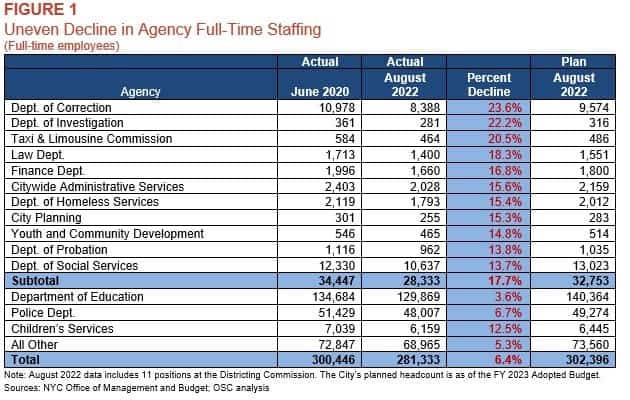
Critical Social Services and Education Programs Could Be Most Impacted
Attrition outpaces hiring among New York City’s municipal workforce, which could have an impact on critical city services and programs, according to a report released today by State Comptroller Thomas P. DiNapoli. The report shows the city’s full-time workforce declined by 19,113 employees over the last two years, the largest decline in staffing since the Great Recession of 2008. Despite the city hiring over 40,000 new employees in the last fiscal year, city job vacancies stand at more than 21,000.
“The pandemic caused a significant decline to the city’s workforce, and it is particularly troubling that turnover continues to outpace hiring,” DiNapoli said. “Without the hardworking individuals who keep this city running, critical and essential services for our children and most vulnerable residents could be impacted. Budget gaps loom, and while the city needs to find efficiencies, it also must prioritize a clear understanding of staffing challenges at its agencies and be transparent about their potential impact on services.”
The 6.4% decrease in the city’s workforce during the pandemic was found to be uneven across its 37 largest agencies, with 11 experiencing a decline in staffing of more than 13%. The Department of Correction had the greatest loss of employees with a 23.6% decline, followed by the Department of Investigation at 22.2% and the Taxi & Limousine Commission at 20.5%.
DiNapoli’s report noted that while a staff reduction at the Department of Correction was planned, the pace was greater than anticipated, and the Police Department (6.7%), Department of Social Services (13.7%), and Administration for Children’s Services (15.6%) accounted for more than half of the citywide workforce decline from June 2020 to August 2022. Other agencies that saw a significant decline in staff included the City Law Department (18.3%), Department of Finance (16.8%), Citywide Administrative Services (15.6%), City Planning (15.3%), Youth and Community Development (14.8%), Department of Probation (13.8%) and the Department of Social Services (13.7%).
DiNapoli’s report also examines divisions within city departments that deliver and oversee critical programs and services, finding 23 had vacancy rates of more than 14%. Divisions within Social Services, Education, Parks and Recreation, Homeless Services, and Mental Health and Hygiene had the highest vacancy rates of more than 20%. This means services for child support, early childhood education, park facility maintenance, and help for the homeless and individuals facing mental health challenges could be disrupted unless more efficient means of providing those services are found.
DiNapoli’s report notes vacancy rates are mostly driven by the city’s temporary reduction in hiring in city fiscal year (FY) 2021 during the pandemic, as well as due to a sharp rise in separations from service which followed. In September, the Mayor ordered New York City agencies to cut spending by 3% in FY 2023 and by 4.75% beginning in FY 2024. While reducing vacancies may be used to achieve part of these savings, the report shows many city departments have yet to even reach their current staffing targets, due to elevated attrition over the past two years.
Across departments, 14 major occupational groups experienced declines of 15% or more, including executive assistants (-27.2%), correction officers (-25.9%), groundskeepers and gardeners (-24.5%), school safety agents (-22.0), information clerks (-21.6%), counselors (-19.4%), lawyers (-19.3%) and legal assistants (-17.4%). Turnover of more than 13% was also shown among fire inspection and prevention occupations, financial officers, architects, accountants and auditors, general office clerks, mechanics and repairers, school administration support staff, social workers, investigators and adjustors, managers, and sheriffs.
The city’s current financial plan looks to fill 24,969 positions by fiscal year 2023. The report called the goal ambitious given current attrition numbers but said all social service agencies had been trying to hire, and that the Administration for Children’s Services and Department of Homeless Services ranked among the highest in number of job listings. In October, more than half of the city’s major agencies had external job postings for at least 20% of their openings, while other major agencies did not show significant efforts to hire as of October 2022.
To protect and ensure a wide range of important city services, DiNapoli recommends that the city:
- Review agencies and divisions for staffing adequacy and consider whether there are staffing challenges or opportunities for efficiencies.
- Publish a detailed review of agency operations by creating a table in the Mayor’s Management Report to help the public understand staff workflow and the impact of current staffing levels on the city’s ability to deliver services based on current and anticipated demand.
- Use existing reports on agency operations to inform decisions over which vacancies may be eliminated for operating efficiencies and which should be filled to improve or expand services.





